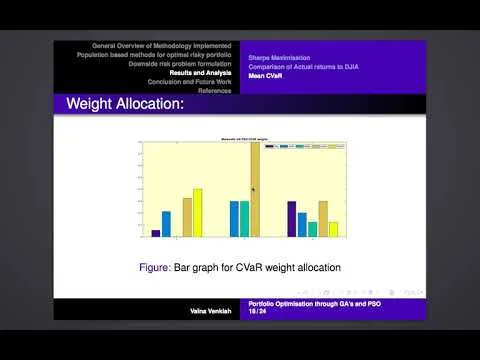
Portfolio Selection and Risk Management 
This course teaches learners how to construct an optimal portfolio, manage risk, and make informed investment decisions. By understanding risk and return measures, diversification, and efficient portfolio management, learners will gain the skills to solve for the best risk-return trade-offs and make optimal asset allocation decisions. Get a comprehesive understanding of this course which is a free course. AZ Class provides this course data for free. Learn more certificate and details here. ▼
ADVERTISEMENT
Course Feature
![]() Cost:
Cost:
Free
![]() Provider:
Provider:
Coursera
![]() Certificate:
Certificate:
Paid Certification
![]() Language:
Language:
English
![]() Start Date:
Start Date:
17th Jul, 2023
Course Overview
❗The content presented here is sourced directly from Coursera platform. For comprehensive course details, including enrollment information, simply click on the 'Go to class' link on our website.
Updated in [October 18th, 2023]
What does this course tell?
(Please note that the following overview content is from the original platform)
When an investor is faced with a portfolio choice problem the number of possible assets and the various combinations and proportions in which each can be held can seem overwhelming In this course you'll learn the basic principles underlying optimal portfolio construction diversification and risk management You'll start by acquiring the tools to characterize an investor's risk and return trade-off You will next analyze how a portfolio choice problem can be structured and learn how to solve for and implement the optimal portfolio solution Finally you will learn about the main pricing models for equilibrium asset prices
Learners will:
Develop risk and return measures for portfolio of assets
Understand the main insights from modern portfolio theory based on diversification
Describe and identify efficient portfolios that manage risk effectively
Solve for portfolio with the best risk-return trade-offs
Understand how risk preference drive optimal asset allocation decisions
Describe and use equilibrium asset pricing models
We considered the value of this course from many aspects, and finally summarized it for you from two aspects: skills and knowledge, and the people who benefit from it:
(Please note that our content is optimized through artificial intelligence tools and carefully reviewed by our editorial staff.)
What skills and knowledge will you acquire during this course?
During this course, learners will acquire the following skills and knowledge:
1. Developing risk and return measures for a portfolio of assets.
2. Understanding the main insights from modern portfolio theory, which is based on diversification.
3. Describing and identifying efficient portfolios that effectively manage risk.
4. Solving for portfolios with the best risk-return trade-offs.
5. Understanding how risk preferences drive optimal asset allocation decisions.
6. Describing and using equilibrium asset pricing models.
Who will benefit from this course?
This course will benefit investors, financial analysts, portfolio managers, and risk managers. It is particularly useful for individuals who are involved in making portfolio choices and managing risk. The course provides learners with the tools and principles necessary to construct optimal portfolios, diversify investments, and effectively manage risk. It teaches learners how to characterize an investor's risk and return trade-off, structure and solve portfolio choice problems, and implement optimal portfolio solutions. Additionally, learners will gain an understanding of risk and return measures, efficient portfolio management, and the role of risk preferences in asset allocation decisions. The course also covers equilibrium asset pricing models, which are essential for pricing assets accurately. Overall, this course is valuable for professionals in the finance industry who want to enhance their portfolio selection and risk management skills.
Course Syllabus
Module 1- Introduction & Risk and Return
This module introduces the second course in the Investment and Portfolio Management Specialization. In this module, we discuss one of the main principles of investing: the risk-return trade-off, the idea that in competitive security markets, higher expected returns come only at a price – the need to bear greater risk. We develop statistical measures of risk and expected return and review the historical record on risk-return patterns across various asset classes.Module 2: Portfolio construction and diversification
In this module, we build on the tools from the previous module to develop measure of portfolio risk and return. We define and distinguish between the different sources of risk and discuss the concept of diversification: how and why putting risky assets together in a portfolio eliminates risk that yields a portfolio with less risk than its components. Finally, we review the quantitative tools that help us identify the ‘best’ portfolios with the least risk for a given level of expected return by considering a numerical example using international equity data.Module 3: Mean-variance preferences
In this module, we describe how investors make choices. Specifically, we look at how utility functions are used to express preferences. We review measures to describe investors’ attitude towards risk. Finally, we discuss how we can summarize investors’ preferences using a specific utility function: mean-variance preferences.Module 4: Optimal capital allocation and portfolio choice
In this module, you will learn about mean-variance optimization: how to make optimal capital allocation and portfolio choice decisions when investors have mean-variance preferences. This was one of the ground-breaking ideas in finance. We will formally set up the investor’s portfolio choice problem and learn step-by-step how to solve for the optimal allocation and risky portfolio choice given a set of risky securities. You will also have an opportunity to apply these techniques to a numerical example. This module is slightly more technical than the others. Stick with it… you will not regret it!Module 5: Equilibrium asset pricing models
In this module, we build on the insights obtained from modern portfolio theory to understand how risk and return are related in equilibrium. We first look at the main workhorse model in finance, the Capital Asset Pricing Model and discuss the expected return-beta relationship. We then turn our attention to multi-factor models, such as the Fama-French three-factor model.Course Provider

Provider Coursera's Stats at AZClass
Discussion and Reviews
0.0 (Based on 0 reviews)
Explore Similar Online Courses

Social Media and Social Content Strategy

AI foundations for business professionals

Python for Informatics: Exploring Information

Social Network Analysis

Introduction to Systematic Review and Meta-Analysis

The Analytics Edge

DCO042 - Python For Informatics

Causal Diagrams: Draw Your Assumptions Before Your Conclusions

Whole genome sequencing of bacterial genomes - tools and applications

PSO& GA for Portfolio Optimisation

Portfolio Optimization using Markowitz Model


Start your review of Portfolio Selection and Risk Management